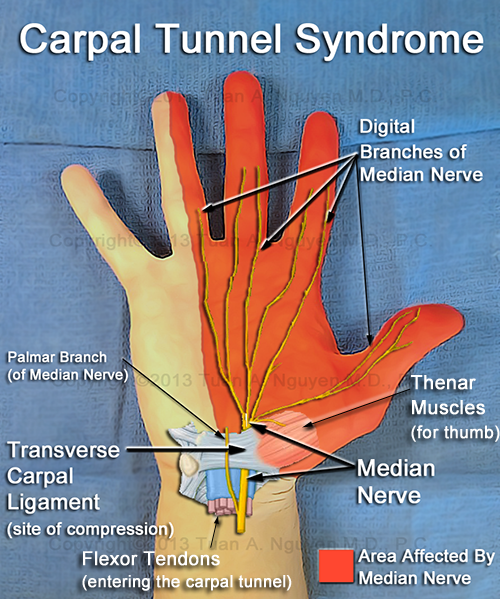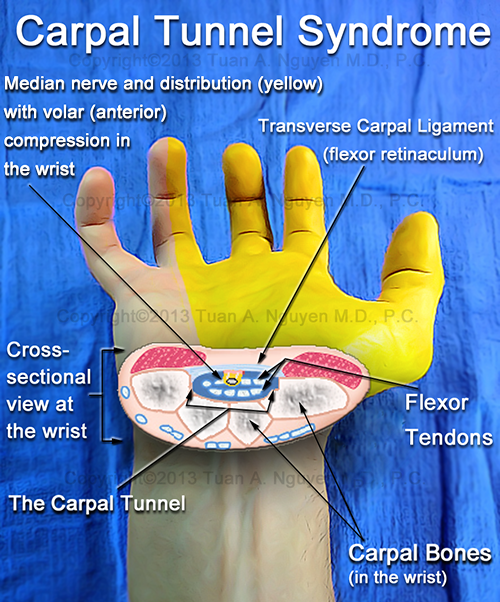Lake Oswego Plastic Surgery®
Tuan A. Nguyen M.D., D.D.S., F.A.C.S.
Board Certified Plastic Surgeon
15820 Quarry Road · Lake Oswego OR 97035
Phone: (503) 635-1955 · Fax: (503) 635-1958
Carpal Tunnel Syndrome
What is carpal tunnel syndrome?
Carpal Tunnel Syndrome (CTS) is a median entrapment neuropathy which causes a constellation of intermittent symptoms including burning, tingling, numbness and pain in the hand or wrist (and sometimes the arm) and occurs with compression of the median nerve as it travels down the arm and through a small tunnel in the wrist on its way to innervate parts of the hand. The carpal tunnel is formed by ligaments and bones of the wrist with a roof made of tough fibrous tissue called the transverse carpal ligament (or flexor retinaculum). The carpal tunnel allows passage from the forearm to the hand of the nine tendons responsible for hand movement and allows passage and protection for the main nerve of the hand (the median nerve and branches) which provide sensory and motor innervation to the hand (thumb, index, middle, and part of the ring finger). (see below) In addition to the symptoms experienced, long-term impairment of the median nerve may result in sensory loss and muscle atrophy, leading to significant suffering and impairment in the afflicted patient.
Fig 1. Anatomical location of the transverse carpal ligament in relation to the median nerve. Distribution of median nerve sensory innervation (red shaded area) in the hand is shown.
Although the name "carpal tunnel syndrome" originated sometime in the 1950's, the condition can be traced back even farther. In the 1890's, the condition was referred to as "acroparesthesia" because of the nighttime burning pain in the fingers described by affected individuals, which is now considered a classic finding associated with CTS. Other names include "tailor's neuritis" and "professional neuritis", both stemming from early observations that CTS was often seen among individuals working in jobs requiring heavy hand usage. In the general population, approximately 3-6% of adults are affected by CTS. CTS is more common in women than men. It is also more common with age, although all ages may be affected.
Fig 2. Cross-sectional view of the carpal tunnel in the wrist with associated anatomical structures. The median nerve is volar (anterior) within the tunnel, compressed by the transverse carpal ligament. Distribution of median nerve sensory innervation (yellow shaded area) in the hand is shown.
What causes carpal tunnel syndrome?
Eventually, in the 1950's, Phalen correctly theorized that CTS was caused by conditions that changed the anatomical dimensions of the carpal tunnel, resulting in median nerve compression. Unfortunately, the exact cause of CTS is often not known, although activities, health conditions, or some combination (multifactorial) likely plays a role.
The symptoms of CTS occur when the median nerve is compressed or put under pressure as it passes through the carpal tunnel in the wrist. In general, anything that decreases the amount of space in the tunnel, increases the amount of tissue in the tunnel, or increases the sensitivity of the median nerve may contribute to the development of CTS. The following predisposing factors do not cause CTS by themselves, but are associated with and increase the chances of developing CTS. They also may aggravate the median nerve with pre-existing disease.
•Any medical or health condition causing inflammation or soft tissue swelling (hypothyroidism, rheumatoid arthritis, obesity, gout, lupus, diabetes, pregnancy, infection), decreased blood flow to the upper extremity (diabetes, smoking/tobacco), or conditions causing peripheral nerve destruction (diabetes, alcoholism). Secondary to its vasoconstrictive nature (reduction in blood flow), smoking can limit vascular supply to the median nerve. CTS secondary to fluid retention (edema) with pregnancy often resolves after delivery and surgical repair is not recommending initially during pregnancy.
•Repetitive hand and wrist movements (especially bending or flexing at the wrist) resulting in tendon or soft tissue inflammation (tenosynovitis, bursitis). Traditionally, CTS has been linked to occupational factors because CTS is extremely common among work-related injuries. This may be secondary to repetitive hand motions (typing), hand/arm vibration (construction/carpentry), and long-periods with the hand/wrist maintained in an anatomically poor position (computers). While these factors may aggravate existing disease, there is limited and conflicting scientific evidence that these activities directly cause CTS.
•Anatomic conditions that decrease space within the carpal tunnel such as a history of trauma to the hand/wrist (dislocations, bone spurs) or tissue growth/tumors (new healing bone formation, ganglion cysts, lipoma, vascular malformation). Additionally, the carpal tunnel area is smaller in women than men, which may explain the higher incidence of CTS in women. Also included are the normal repetitive forces and trauma experienced with aging.
•Biological factors such as genetic predisposition and anthropometric studies have demonstrated some causal association with CTS.
•No single cause identified (idiopathic). While there are many health conditions and environmental factors that play a role in the development of CTS, often the cause is multifactorial and no direct causative factor is identified.
![]() Continue to "Signs and Symptoms"
Continue to "Signs and Symptoms"
To learn more about Carpal Tunnel Syndrome and treatment options, Please Call or Email To Schedule A Consultation
Call Us
Email Us
tuananguyenmd@gmail.com
![]()
Click to Email
Lake Oswego Plastic Surgery
Additional Information
Please see the provided Additional Links and Resources about Carpal Tunnel Syndrome for additional information and references.


